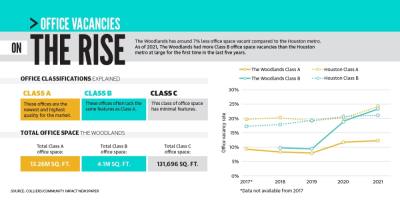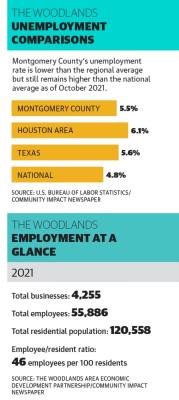ExxonMobil confirmed in an Oct. 26 statement it will move staff in The Woodlands back to its Spring facility after voluntarily ending a tax abatement with The Woodlands Township on Oct. 11. The company did not maintain the required number of staff at buildings it occupied in Hughes Landing, according to Kevin Gerrity, ExxonMobil’s global strategy manager.
“As we work with various tax jurisdictions and discussions are resolved, we look forward to welcoming those employees back to our larger space on the Houston campus [in Spring], where teams are able to collaborate in a central location,” said Todd Spitler, corporate media relations senior adviser with ExxonMobil, in an email.
The Greater Houston area is seeing a rising number of office vacancies, according to the Greater Houston Partnership. However, The Woodlands’ office vacancy rate remains lower than the regional average, and area economists are expressing optimism going into 2022.
Hiranya Nath, a professor of economics at Sam Houston State University, said shifts that have occurred since 2020 are likely to remain for some time.
“Changes like working remotely, online shopping, telehealth are likely to stay in the post-COVID[-19] world and will have long-lasting impacts on employment,” Nath said.
Vacant spaces
Patrick Jankowski, senior vice president of research at the Greater Houston Partnership, said more than 361,000 jobs were lost in the Greater Houston area from March to April 2020, and office vacancies increased as a result of the recession caused by the coronavirus pandemic.
“I first began my career here in 1981 right after the oil bust. We thought that was a completely horrible recession. We lost 226,000 jobs,” Jankowski said during a Sept. 30 presentation to The Woodlands Area Economic Development Partnership. “If you go to the Great Recession, ... we lost 120,000. The COVID[-19] recession was worse than both of those combined.”
Jankowski said a total of 221,500 jobs have been recovered so far in the region with 56,000 being added from January to August.
However, Jankowski noted there is between 60 million and 70 million square feet of vacant office space across the Greater Houston area.
According to a third-quarter 2021 report from real estate firm Colliers International, the region has a total of 23.3% office vacancies across the board, up from 21.3% in the previous year. The same report indicates The Woodlands’ vacancy rate was faring better with about 16.3% vacancies compared to 16.8% the previous year.
According to Gil Staley, CEO of The Woodlands Area Economic Development Partnership, going back to the office is an issue for many area employers.
“We still have so many that are working virtually,” Staley said.
Historic information from Colliers indicates office vacancies in The Woodlands had been on a consistent decline, dropping from 12.8% in 2016 to 8.3% in 2019 prior to the pandemic.
Prior to ExxonMobil confirming it was leaving the office spaces in Hughes Landing, Staley said the company provided around 1,500 jobs for the area.
“That [reflects] the decline in energy jobs for us in our market,” Staley said.
During his presentation in September, Jankowski said he anticipates seeing companies attempting to move from Class B to Class A office spaces and Class C buildings possibly being torn down for another use. Class A spaces are considered the highest quality.
“I have not been able to figure out how we get out of this office situation,” Jankowski said. “As far as getting the rates back up, we are a long way away.”
Shifting trends
The oil and gas industry no longer has the largest number of nonretail employees among companies in The Woodlands area with at least 100 employees. However, Staley said medical employment will continue to grow through 2022 as both Houston Methodist The Woodlands Hospital and Memorial Hermann The Woodlands Medical Center complete expansions in the first quarter of 2022.
“Health care is still the leading sector by double-digit growth,” Staley said.
Nath said the oil and gas industry is not the only industry to see a decline since 2020.
“The disruptions to the global supply chain have direct and indirect effects on almost every sector and have been partly responsible for higher inflation in recent months,” Nath said.
One industry The Woodlands Area EDP is attempting to bring to the region is biopharmaceuticals. Staley said the partnership is in talks with several organizations based out of California that could bring several hundred jobs with them if they relocated to the area but could not provide examples or specifics.
Information from The Woodlands Area EDP indicates that of the nonretail employers in the area that have at least 100 employees, life sciences make up about 0.6% of jobs.
Another sector that saw growth in 2020 but has now stalled is manufacturing. Staley said as of Oct. 25, there have been no updates from Wildcat PPE, a personal protective equipment distributor that furloughed most of its workforce in April. The business was the third-largest employer in The Woodlands with over 2,000 employees hired during the pandemic. Wildcat could not be reached for comment before press time.
Staley added while The Woodlands Area EDP does not actively recruit retail businesses, the industry has experienced a recovery.
“There are major retailers that want to enter our market,” he said. “We are excited about what retail has for the future; it seems to be very active right now.”
Information provided by Caldwell Cos. shows that as of Oct. 4, retail vacancies were at 5.2% compared to the previous year’s rate of 5.7%.
Market Street Marketing Director Noemi Gonzalez attributed the mixed-use shopping center’s resilience to a diverse tenant mix.
“We have opened 10 new retailers this year in addition to the relocation and expansion of several others and anticipate similar growth in 2022,” Gonzalez said
The future of energy
Staley said the energy industry will need to be watched closely for change.
“All anticipation is that these higher oil prices will be sustainable for a while,” he said. “If this is truly the case, we will see increased jobs in the energy sector.”
Jankowski said regional oil prices have been on a steady rise since April 2020, when prices hit a low of $16.55 per barrel. Those were up to more than $80 per barrel in late October.
“What is interesting about that, most oil and gas can make profit at $50 per barrel,” Jankowski said. “But if you look at that ... the [active] rig count has not picked up. The oil and gas industry’s woes started prior to the pandemic.”
Staley said he believes there could be a possibility of renewable energy in the area in the form of carbon recapture, which could create jobs. However, Staley noted industries such as wind and solar might not see a market in The Woodlands area due to the operations and industrial space needed.
Monthly data from Caldwell Cos. indicates industrial vacancy has declined in The Woodlands over the past year, from 8.5% in October 2020 to 6.6% as of Oct. 4. The data also indicates there were no new industrial spaces under construction.
“We all know there is a surge in that growth, and the Houston region wants to be in the forefront of that growth,” Staley said.
He said The Woodlands is positioned to advance the economy due to the assets and educated workers in the area.
“We are well positioned for opportunities, better perhaps than other markets in the Houston region,” Staley said. “I am confident that we will return. We think we are positioned to take advantage of any opportunities that come up.”







